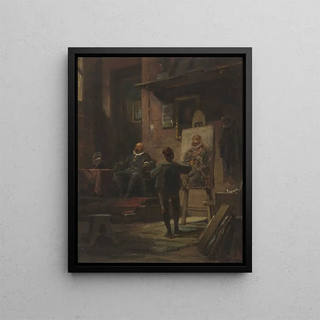Painting The Painter - Carl Spitzweg | Art print


View from behind

Frame (optional)
In the enchanting world of art, some works transcend time and space, captivating the mind and sparking the imagination. "The painter" by Carl Spitzweg is one of those creations that, through its charm and delicacy, transports us to a time when art was a true celebration of life. This piece, both intimate and universal, depicts a fleeting moment, a reflection on the beauty of the creative act. By contemplating this art print, one is immersed in an artist's studio, where each brushstroke seems to tell a story, a quest for meaning through color and light.
Style and uniqueness of the work
Carl Spitzweg's style is distinguished by its ability to combine realistic precision with subtle poetry. In "The painter," the artist manages to capture not only the physical appearance of his subject but also its essence, its passion for creation. The choice of colors, soft and harmonious, evokes a warm, almost nostalgic atmosphere. The light, carefully orchestrated, illuminates the painter's face, revealing an expression of concentration and devotion. Every detail, from the delicately held brush to the ongoing canvas, testifies to a deep love for art. This work is not merely a simple representation; it invites the viewer to feel the emotion emanating from the act of painting, to question what lies behind each tableau.
The artist and his influence
Carl Spitzweg, an emblematic figure of German Romanticism, knew how to mark his era with his unique approach to art. Born in 1808, he initially worked as a pharmacist before fully dedicating himself to painting. His work is characterized by a tender view of life and its small things, often populated with solitary characters or scenes of everyday life. Spitzweg captured the soul of his time, blending humor and melancholy, which allowed him to reach a broad audience. His influence endures today, inspiring many contemporary artists who see in him a precursor of artistic introspection. "The painter" is a perfect example of this duality, where the

Matte finish

View from behind

Frame (optional)
In the enchanting world of art, some works transcend time and space, captivating the mind and sparking the imagination. "The painter" by Carl Spitzweg is one of those creations that, through its charm and delicacy, transports us to a time when art was a true celebration of life. This piece, both intimate and universal, depicts a fleeting moment, a reflection on the beauty of the creative act. By contemplating this art print, one is immersed in an artist's studio, where each brushstroke seems to tell a story, a quest for meaning through color and light.
Style and uniqueness of the work
Carl Spitzweg's style is distinguished by its ability to combine realistic precision with subtle poetry. In "The painter," the artist manages to capture not only the physical appearance of his subject but also its essence, its passion for creation. The choice of colors, soft and harmonious, evokes a warm, almost nostalgic atmosphere. The light, carefully orchestrated, illuminates the painter's face, revealing an expression of concentration and devotion. Every detail, from the delicately held brush to the ongoing canvas, testifies to a deep love for art. This work is not merely a simple representation; it invites the viewer to feel the emotion emanating from the act of painting, to question what lies behind each tableau.
The artist and his influence
Carl Spitzweg, an emblematic figure of German Romanticism, knew how to mark his era with his unique approach to art. Born in 1808, he initially worked as a pharmacist before fully dedicating himself to painting. His work is characterized by a tender view of life and its small things, often populated with solitary characters or scenes of everyday life. Spitzweg captured the soul of his time, blending humor and melancholy, which allowed him to reach a broad audience. His influence endures today, inspiring many contemporary artists who see in him a precursor of artistic introspection. "The painter" is a perfect example of this duality, where the
12,34 €






